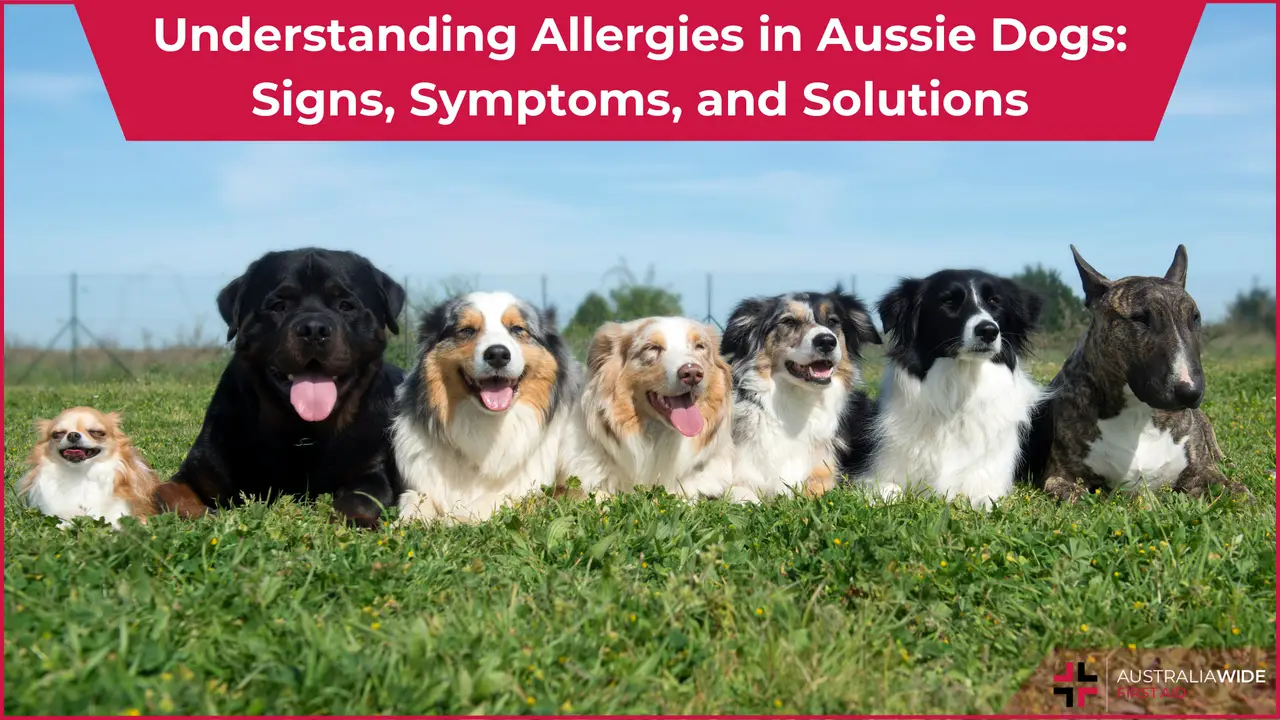Understanding Allergies in Aussie Dogs: Signs, Symptoms, and Solutions


Australia is known for its diverse fauna, scenic landscapes, and a pet-loving culture.
Amongst the most cherished companions are dogs, whose well-being is paramount to Australian pet owners.
However, like humans, our canine friends are susceptible to allergies, which can significantly affect their quality of life.
This article aims to shed light on common allergies in dogs, their signs and symptoms, treatment options, and advice on when to consult a veterinarian.
Allergies in dogs manifest when their immune systems begin to recognize certain everyday substances—or allergens—as dangerous. These allergens can range from flea bites to food ingredients and even to the pollen from Australia's many plants and trees. Here are some of the most prevalent canine allergies encountered by pet owners down under:
1. Flea Allergy Dermatitis
This is a hypersensitivity to flea bites, more specifically to flea saliva. Even a single bite can trigger an intense allergic reaction in your dog.
2. Atopic Dermatitis
Atopy refers to environmental allergies. Dogs may react to dust mites, mould, or pollens from grasses, trees, and flowers—common in Australia's rich natural environment.
3. Food Allergies
Some dogs develop allergies to specific food components such as beef, chicken, soy, or grains. Unlike in humans, however, true food allergies are rare in dogs.
4. Contact Allergies
Contact allergies arise when a dog's skin reacts to something it touches, such as certain plants, chemicals, or even the fabrics used in bedding.

Recognizing the signs and symptoms of allergies can be tricky, as they often resemble other conditions.
Nevertheless, here are the common indicators that your dog might be suffering from an allergy:
1. Flea Control
For flea allergies, the first step is effective flea control. This involves not only treating the dog but also managing the environment to prevent flea infestations.
2. Avoidance
Identifying and avoiding the allergen, wherever possible, especially with contact and food allergies, can help manage symptoms.
3. Medications
Various medications, including antihistamines, corticosteroids, or more advanced therapies like immunomodulatory drugs, can be prescribed by vets to help control allergic reactions.
4. Immunotherapy
Veterinarians may suggest allergy shots or sublingual immunotherapy, which involve exposing the dog to small amounts of allergens to gradually build up tolerance.
5. Dietary Changes
For food allergies, an elimination diet—where you feed your dog a simplified diet and then reintroduce food items to pinpoint the allergy—can be effective.
6. Topical Treatments
Special shampoos, creams, or ointments can alleviate skin irritation and inflammation.

If your dog shows any signs of allergy, it is important to seek veterinary advice.
Allergies can be uncomfortable and even painful for dogs, and without appropriate treatment, they can lead to more severe health issues.
A vet can perform tests to identify the specific allergen and recommend a comprehensive treatment plan.
Additionally, if you observe any of the following symptoms, visit your veterinarian promptly:
Living with allergies can be tough for your canine companion, but with careful observation and proper veterinary care, they can lead a happy and healthy life.
Australian pet owners must be cognizant of the potential for allergies due to the unique flora, fauna, and climate in the region.
Remember, prevention is often the best medicine. Regular cleaning, proper diet, and routine vet check-ups can minimize the risk of allergies and ensure your pet lives a full and vivacious life. And when allergies do occur, understanding and responding to the symptoms can make all the difference.
Love and vigilance are the hallmarks of excellent pet care; managing allergies is no different. If you suspect your dog may be suffering from an allergy, take heart in the fact that with modern veterinary medicine, there are ample opportunities to relieve your furry friend's discomfort.
For the love of our loyal companions, staying informed and proactive in the face of allergies can affirm the bond we share with our beloved dogs—a testament to the care and companionship they so depend on us to provide.

April 16, 2024
Like humans, our canine friends are susceptible to allergies, which can significantly affect their quality of life. This article aims to shed light on common allergies in dogs, their signs and symptoms, treatment options, and advice on when to consult a veterinarian.

March 19, 2024
From respiratory distress to changes in droppings and abnormal behaviours, this guide outlines the key indicators of illness that require immediate attention. By understanding these warning signs, bird owners can take proactive steps to ensure their feathered companions receive timely medical treatment, ultimately promoting their health and well-being.

February 12, 2024
In the hustle and bustle of our daily lives, it's easy to overlook that our furry friends may not be leading lives as fulfilled as we'd like. Just like humans, dogs too can suffer from monotony, especially those spending large amounts of time indoors. Recognizing and addressing boredom in our canine companions is crucial for their overall well-being.